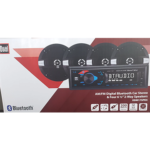Upgrading your car audio system requires more than just new speakers and amplifiers. You also need a reliable and high-performance battery to power up your system. A car audio battery is responsible for providing the necessary power to your car’s audio system, ensuring that you enjoy your favorite tunes while driving.
However, not all car audio batteries are created equal. Traditional lead-acid batteries may have been the norm, but the emergence of lithium car audio batteries has revolutionized the car audio industry. In this guide, we’ll discuss the benefits of using a lithium car audio battery, the best battery for car audio, car audio dual battery setup, installation of a second battery, and more.
Lithium Car Audio Battery
A. Features and benefits of lithium car audio batteries
Lithium car audio batteries are lightweight, compact, and offer higher energy density compared to traditional lead-acid batteries. This means that they can provide the same amount of power with less space and weight. Moreover, they have a longer lifespan, can handle more charge-discharge cycles, and can be recharged faster.
B. Factors to consider when choosing a lithium battery for car audio
When choosing a lithium battery for your car audio system, consider factors such as the battery’s capacity, voltage, and size. Ensure that the battery’s capacity can handle the power requirements of your car’s audio system and that its voltage matches that of your car’s electrical system. Also, consider the battery’s size and weight, and ensure that it fits in your car’s battery compartment.
Best Battery for Car Audio
A. Top brands and models of car audio batteries
Some of the top brands and models of car audio batteries include XS Power, Kinetik, Odyssey, and NorthStar. These brands offer a range of batteries with different capacities and features to suit various car audio setups.
B. Pros and cons of different types of car audio batteries
Different types of car audio batteries include lead-acid, lithium-ion, and AGM (absorbed glass mat) batteries. Each type has its pros and cons, such as lead-acid batteries being more affordable but having a shorter lifespan, while lithium-ion batteries are more expensive but have a longer lifespan and higher energy density.
Extra Battery for Car Audio System Diagram
A. Understanding the concept of a second battery for car audio
An extra battery for car audio, also known as a secondary battery, is a second battery that is added to your car’s electrical system to power your car’s audio system. The primary battery powers the car’s starter motor and other electrical components, while the secondary battery powers the car’s audio system.
B. Diagram and explanation of an extra battery for car audio system
An extra battery for car audio is typically installed in parallel with the primary battery, using a battery isolator or relay to ensure that each battery is charged independently. The diagram for an extra battery for a car audio system shows the primary battery, the secondary battery, the battery isolator, and the car audio system.
C. Benefits of having a secondary battery for car audio
Having a secondary battery for car audio ensures that your car audio system has a dedicated power source, preventing it from draining the primary battery and affecting the performance of other electrical components. It also allows for longer playtime and eliminates the risk of a dead battery, especially when using the car’s audio system while the engine is off.
Car Audio Dual Battery Setup
A. Understanding the concept of a dual battery setup for car audio
A car audio dual battery setup involves installing two batteries in your car’s electrical system to power your car audio system. It can be either a parallel setup, where both batteries are connected in parallel to the car’s electrical system or a series setup, where both batteries are connected in series to provide a higher voltage output.
B. Components and tools needed for a car audio dual battery setup
To install a car audio dual battery setup, you’ll need batteries, battery terminals, battery cables, a battery isolator or relay, a fuse holder, a fuse, and basic tools such as wire cutters, crimpers, and a drill.
C. Step-by-step guide on how to install a dual battery setup for car audio
- Choose the appropriate battery: Select a battery that is compatible with your car’s electrical system, car audio system, and type of use.
- Determine the placement: Choose a location for the secondary battery that is safe, secure, and easily accessible. Some common locations include the trunk or under the hood.
- Connect the battery: Use appropriate battery terminals and cables to connect the battery to the car’s electrical system and the car’s audio system.
- Install a battery isolator or relay: Use a battery isolator or relay to ensure that each battery is charged independently and that the primary battery is not affected by the car audio system’s power consumption.
- Connect the car audio system: Connect the car audio system to the secondary battery, ensuring that all connections are secure and properly insulated.
- Install a fuse holder and fuse: Install a fuse holder and fuse to protect the car’s audio system from power surges and other electrical issues.
When to add a second battery for car audio
A. Understanding when to add a second battery for car audio
Adding a second battery for car audio is necessary when the car audio system draws too much power from the primary battery, causing voltage drops, dimming lights, and other electrical issues. Other factors that may necessitate a second battery include extended playtime, high power demands, and the use of amplifiers and subwoofers.
B. Signs that indicate a need for a second battery for car audio
Signs that indicate a need for a second battery for car audio include:
- Dimming headlights: If the headlights dim when playing loud music, it means that the car’s audio system is drawing too much power from the primary battery.
- Battery draining quickly: If the primary battery drains quickly, it means that the car’s audio system is not getting enough power to keep it running.
- Voltage drops: If the voltage drops below 12 volts, it means that the primary battery is not supplying enough power to the car audio system.
- Engine not starting: If the engine fails to start or takes a long time to start, it means that the primary battery is drained or weak.
Car Audio Battery Terminals
A. Understanding the importance of car audio battery terminals
Car audio battery terminals are the connectors that attach the battery to the car’s electrical system and the car audio system. They play a crucial role in ensuring a secure and reliable connection between the battery and the system.
B. Types of car audio battery terminals
There are various types of car audio battery terminals, including top-post terminals, side-post terminals, and universal terminals. Each type has its advantages and disadvantages, such as top-post terminals being more versatile and side-post terminals being more compact.
C. Tips for choosing and installing car audio battery terminals
When choosing car audio battery terminals, ensure that they are compatible with your car’s electrical system and the battery’s type and size. When installing them, ensure that the terminals are tightened securely and that the cables are connected properly.
Car Audio Capacitor vs. Battery
A. Understanding the difference between a car audio capacitor and a battery
A car audio capacitor is an electronic device that stores and releases electrical energy quickly, providing a burst of power when needed, while a car audio battery stores and releases electrical energy over a longer period.
B. Pros and cons of using a car audio capacitor vs. a battery
The pros of using a car audio capacitor include quick power delivery, easy installation, and affordability, while the cons include limited energy storage, a short lifespan, and limited effectiveness for larger audio systems. The pros of using a car audio battery include longer energy storage, reliable performance, and effectiveness for larger audio systems, while the cons include higher cost, bulkier size, and a need for maintenance.
C. Which is better for car audio, a capacitor or a battery?
The choice between a car audio capacitor and a battery depends on the type and size of the car audio system, the available space, the budget, and personal preferences. Generally, a car audio capacitor is more suitable for smaller audio systems with lower power requirements, while a car audio battery is more suitable for larger audio systems with higher power requirements.
Conclusion
A car audio battery is an essential component of a car audio system, providing power for the amplifiers, subwoofers, and other accessories. Lithium car audio batteries are the best option for car audio systems, offering several advantages over traditional lead-acid batteries, such as longer lifespan, faster charging, and higher power density. Adding a second battery for car audio is necessary when the car audio system draws too much power from the primary battery, causing voltage drops, dimming lights, and other electrical issues. By following the steps outlined in this article, users can install a second battery for car audio and enjoy improved performance, longer playtime, and enhanced reliability.



